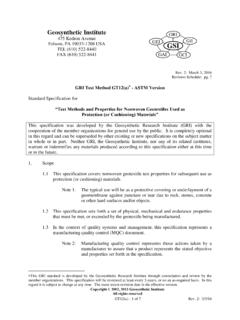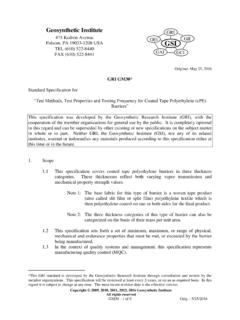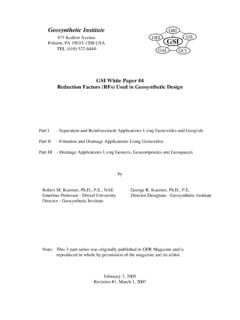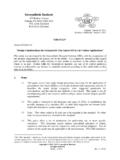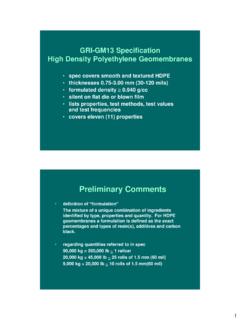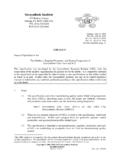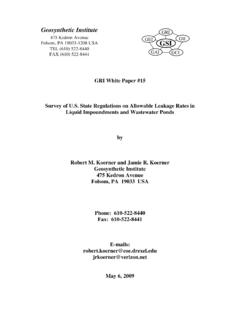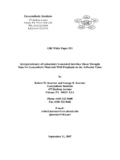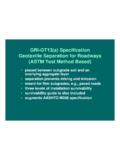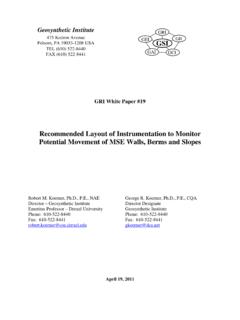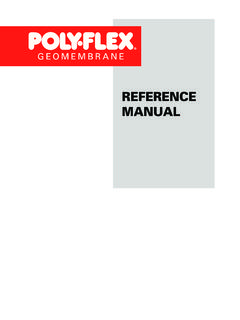Transcription of Geosynthetic Institute GRI 475 Kedron Avenue GII Folsom ...
1 Geosynthetic Institute GRI. 475 Kedron Avenue GEI GII. Folsom , PA 19033-1208 USA GSI. TEL (610) 522-8440. FAX (610) 522-8441 GAI GCI. Revision 14: January 6, 2016. Revision schedule on pg. 11. GRI - GM13 Standard Specification*. Standard Specification for Test Methods, Test Properties and Testing Frequency for High Density Polyethylene (HDPE) Smooth and Textured Geomembranes SM. This specification was developed by the Geosynthetic Research Institute (GRI), with the cooperation of the member organizations for general use by the public. It is completely optional in this regard and can be superseded by other existing or new specifications on the subject matter in whole or in part. Neither GRI, the Geosynthetic Institute , nor any of its related institutes, warrant or indemnifies any materials produced according to this specification either at this time or in the future.
2 1. Scope This specification covers high density polyethylene (HDPE) geomembranes with a formulated sheet density of g/ml, or higher, in the thickness range of mm (30 mils) to mm (120 mils). Both smooth and textured geomembrane surfaces are included. This specification sets forth a set of minimum, physical, mechanical and chemical properties that must be met, or exceeded by the geomembrane being manufactured. In a few cases a range is specified. In the context of quality systems and management, this specification represents manufacturing quality control (MQC). Note 1: Manufacturing quality control represents those actions taken by a manufacturer to ensure that the product represents the stated objective and properties set forth in this specification. This standard specification is intended to ensure good quality and performance of HDPE geomembranes in general applications, but is possibly not adequate for the complete specification in a specific situation.
3 Additional tests, or more restrictive *This GRI standard specification is developed by the Geosynthetic Research Institute through consultation and review by the member organizations. This specification will be reviewed at least every 2-years, or on an as-required basis. In this regard it is subject to change at any time. The most recent revision date is the effective version and it is kept current on the Institute 's Website << >>. Copyright 2017 Geosynthetic Institute - All Rights Reserved GM13 - 1 of 11 Revision 14: 1/6/16. values for test indicated, may be necessary under conditions of a particular application. Note 2: For information on installation techniques, users of this standard are referred to the geosynthetics literature, which is abundant on the subject.
4 2. Referenced Documents ASTM Standards D 792 Specific Gravity (Relative Density) and Density of Plastics by Displacement D 1004 Test Method for Initial Tear Resistance of Plastics Film and Sheeting D 1238 Test Method for Flow Rates of Thermoplastics by Extrusion Plastometer D 1505 Test Method for Density of Plastics by the Density-Gradient Technique D 1603 Test Method for Carbon Black in Olefin Plastics D 3895 Test Method for Oxidative Induction Time of Polyolefins by Thermal Analysis D 4218 Test Method for Determination of Carbon Black Content in Polyethylene Compounds by the Muffle-Furnace Technique D 4833 Test Method for Index Puncture Resistance of Geotextiles, Geomembranes and Related Products D 5199 Test Method for Measuring Nominal Thickness of Geotextiles and Geomembranes D 5397 Procedure to Perform a Single Point Notched Constant Tensile Load.
5 (SP-NCTL) Test: Appendix D 5596 Test Method for Microscopic Evaluation of the Dispersion of Carbon Black in Polyolefin Geosynthetics D 5721 Practice for Air-Oven Aging of Polyolefin Geomembranes D 5885 Test method for Oxidative Induction Time of Polyolefin Geosynthetics by High Pressure Differential Scanning Calorimetry D 5994 Test Method for Measuring the Core Thickness of Textured Geomembranes D 6370 Standard Test Method for Rubber-Compositional Analysis by Thermogravimetry (TGA). D 6693 Test Method for Determining Tensile Properties of Nonreinforced Polyethylene and Nonreinforced Flexible Polypropylene Geomembranes D 7238 Test Method for Effect of Exposure of Unreinforced Polyolefin Geomembrane Using Fluorescent UV Condensation Apparatus D 7466 Test Method for Measuring the Asperity Height of Textured Geomembranes GRI Standards GM10 Specification for the Stress Crack Resistance of Geomembrane Sheet GM13 - 2 of 11 Revision 14: 1/6/16.
6 U. S. Environmental Protection Agency Technical Guidance Document " quality control assurance and quality control for Waste Containment Facilities,". EPA/600/R-93/182, September 1993, 305 pgs. 3. Definitions Manufacturing quality control (MQC) - A planned system of inspections that is used to directly monitor and control the manufacture of a material which is factory originated. MQC is normally performed by the manufacturer of Geosynthetic materials and is necessary to ensure minimum (or maximum) specified values in the manufactured product. MQC refers to measures taken by the manufacturer to determine compliance with the requirements for materials and workmanship as stated in certification documents and contract specifications. ref. EPA/600/R-93/182. Manufacturing quality assurance (MQA) - A planned system of activities that provides assurance that the materials were constructed as specified in the certification documents and contract specifications.
7 MQA includes manufacturing facility inspections, verifications, audits and evaluation of the raw materials (resins and additives) and Geosynthetic products to assess the quality of the manufactured materials. MQA refers to measures taken by the MQA organization to determine if the manufacturer is in compliance with the product certification and contract specifications for the project. ref. EPA/600/R-93/182. Formulation - The mixture of a unique combination of ingredients identified by type, properties and quantity. For HDPE polyethylene geomembranes, a formulation is defined as the exact percentages and types of resin(s), additives and carbon black. Nominal - Representative value of a measurable property determined under a set of conditions, by which a product may be described.
8 Abbreviated as nom. in Tables 1 and 2. 4. Material Classification and Formulation This specification covers high density polyethylene geomembranes with a formulated sheet density of g/ml, or higher. Density can be measured by ASTM D1505 or ASTM D792. If the latter, Method B is recommended. The polyethylene resin from which the geomembrane is made will generally be in the density range of g/ml or higher, and have a melt index value per ASTM. D1238 of less than g/10 min. The resin shall be virgin material with no more than 10% rework. If rework is used, it must be a similar HDPE as the parent material. No post consumer resin (PCR) of any type shall be added to the formulation. GM13 - 3 of 11 Revision 14: 1/6/16. 5. Physical, Mechanical and Chemical Property Requirements The geomembrane shall conform to the test property requirements prescribed in Tables 1 and 2.
9 Table 1 is for smooth HDPE geomembranes and Table 2 is for single and double sided textured HDPE geomembranes. Each of the tables are given in English and SI (metric) units. The conversion from English to SI. (metric) is soft. Note 3: The tensile strength properties in this specification were originally based on ASTM D 638 which uses a laboratory testing temperature of 23 C 2 C. Since ASTM Committee D35 on Geosynthetics adopted ASTM D 6693 (in place of D 638), this GRI Specification followed accordingly. The difference is that D 6693 uses a testing temperature of 21 C 2 C. The numeric values of strength and elongation were not changed in this specification. If a dispute arises in this regard, the original temperature of 23 C 2 C should be utilized for testing purposes.
10 Note 4: There are several tests often included in other HDPE specifications which are omitted from this standard because they are outdated, irrelevant or generate information that is not necessary to evaluate on a routine MQC basis. The following tests have been purposely omitted: Volatile Loss Water Absorption Dimensional Stability Ozone Resistance Coeff. of Linear Expansion Modulus of Elasticity Resistance to Soil Burial Hydrostatic Resistance Low Temperature Impact Tensile Impact ESCR Test (D 1693) Field Seam Strength Wide Width Tensile Multi-Axial Burst Water Vapor Transmission Various Toxicity Tests Note 5: There are several tests which are included in this standard (that are not customarily required in other HDPE specifications) because they are relevant and important in the context of current manufacturing processes.
